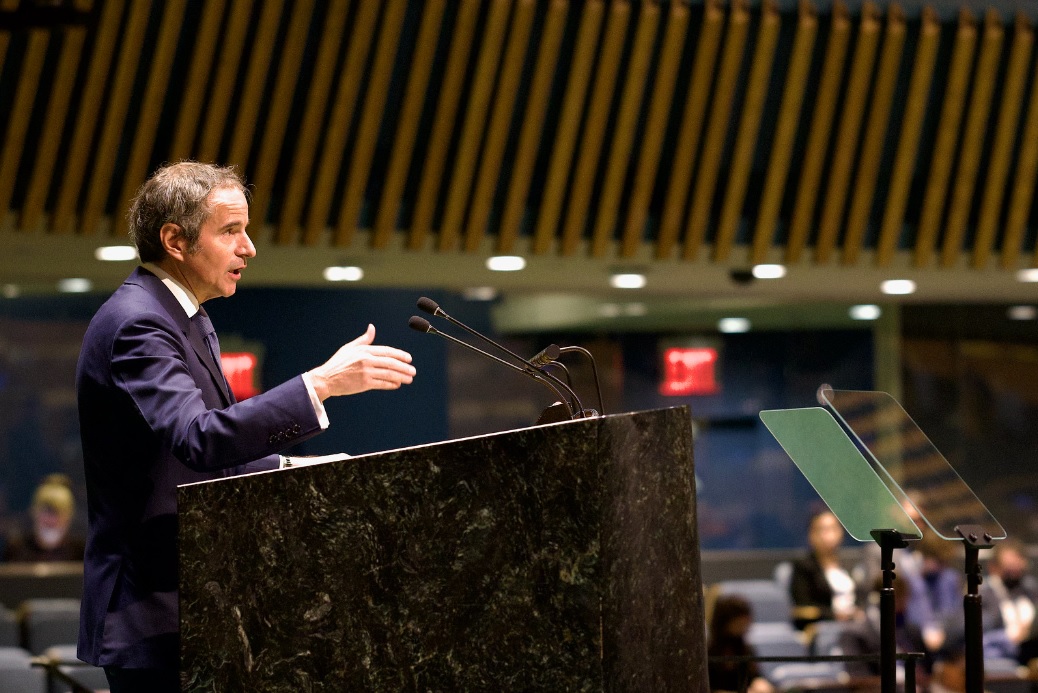Student Blog by Anton Stalchenko*
Summary
- Full-fledged invasion by Russia buries Budapest Memorandum and leads Global Nuclear Order disarray
- 2022 Nuclear Non-Proliferation Review Conference collapsed due to the lack of unity after Russia’s invasion
- The appropriation of civilian nuclear facilities, used as a negotiation and coercion token amid war and illegal invasion, has been condemned widely by the global community and the UN
- The chain of events has triggered a Nuclear Modernization Race led by the US, Russia, and China, and has raised concerns over possible race for the nuclear weapon acquisition by Iran and Saudi Arabia
Budapest Memorandum
Since 2014, the role of Budapest Memorandum and its impact has remained under a big question mark. The Budapest Memorandum was signed by the US, UK, Russia with Ukraine in OSCE conference in Hungary on December 1994. In the document the three aforementioned nuclear weapon states guaranteed, despite being worded as assurances, Ukraine’s territorial and political sovereignty in exchange for Ukraine giving up the nuclear weapons it inherited from Soviet Union (similar agreements were made with Belarus and Kazakhstan).
In Munich Security Conference in 2022, Ukraine’s President, Volodymyr Zelensky, called for additional consultations regarding the Memorandum, but to no avail (The Kyiv Independent 2022). Moreover, Russia’s invasion of Ukraine has buried any doubts or confusion about the true significance of the treaty. To put it bluntly, it was merely a piece of paper as valuable as the Soviet rubles after the regime’s collapse in 1991. As a result of Russia’s blatant violation of the Budapest memorandum, this leaves us with a much grayer area about what the future of non-proliferation will be like, especially given that the memorandum has been one the most obvious instances of successful processes of denuclearization.
According to Alexander K. Bollfrass & Stephen Herzog (2022), the violation of the Budapest Memorandum and invasion of Ukraine is not solely about Ukraine, the US, or Russia, but also about the future of global nuclear order and its status quo. The authors claim that there is just no way that Ukraine could or should accept any peace agreements that would violate its sovereignty. Giving up on this would mean that states with nuclear weapons could act carelessly and unpunished because they have a “bigger stick.” However, the authors also pointed out that nuclear order has been quite resilient. On the one hand, we indeed have a global nuclear security crisis, but at the same the existing security architecture has thus far managed to avoid global nuclear annihilation.
Nuclear Non-Proliferation Review Conference
Even before 2022, global nuclear order has experienced challenges and a lack of cohesion. A substantial portion of non-nuclear weapon states (nnws) support a complete ban of nuclear weapons. Meanwhile, nuclear weapon states (nws) are seeking ways to diverge attention from the issue and frame the discussion on deterrence, nuclear risk avoidance, security assurances and proliferation risks using the NPT as “good enough” solution for the problem. Moreover, due to the change of power in the United States, there was a hope that 2022 could become a year of positive changes in the Non-Proliferation Treaty (NPT) Review Conference (RevCon).
Alas, despite the hopes, and assumptions about 2022 NPT Review Conference, everything went in mayhem with Russia rejecting the final document. On August 26, 2022, the Nuclear Non-Proliferation conference had concluded without any substantial agreements. In particular, the attention was stressed on Delegates from Russian Federation rejecting the final review document by stating that there was formed an unfriendly coalition initiated by the delegates supporting Ukraine. The solidarity against Russia’s nuclear coercion, a member of UN security council, was strong among the UN member states at the conference. Second, there was a stress on condemnation of using a civilian nuclear facilities for military purposes, pointing to the escalation at the Zaporizhia Nuclear Power Plant (NPT Review Conference, 2022).
Safety and Security Crisis of the Peaceful Atom – The Case of Zaporizhia Nuclear Power Plant
The Russian invasion campaign created a new precedence of Security Council member using civilian nuclear power plants as part of it’s coercive negotiation strategy. Hence, during February 2022 invasion of Ukraine, Russia had captured Chernobyl Nuclear Plant and Zaporizhia Plant. The history of Chernobyl might be apparent to many, but not many were aware that Zaporizhian Nuclear Plant is one of the largest in Europe.
Russia took control over the plants under pretense that Ukraine anticipated to make a dirty bomb, without any indications of intent or evidence (IAEA Director General, 2022). Nevertheless, the use of Zaporizhia Nuclear Plant as negotiation token was used so actively that International Atomic Energy Agency (IAEA) had to enter to de-escalate the situation and to guarantee the safe operations in the nuclear power plant at Zaporizhia. As of today, the fate of the plant remains ambiguous, but any unsanctioned interference with it could end-up being catastrophic for everyone (Wahlquist & Lu, 2022).
Nuclear Arsenal Modernization in the 21st Century
The collapse of cohesion among the member states during RevCon, creation of additional layers in nuclear treaties, and invasion of Ukraine has triggered a quite threatening chain of events that could have been and should have been avoided. Hence, in François Diaz-Maurin’s 2022 global nuclear order review we have a situation where the threat of nuclearization has reached its unprecedent rise. The account on the situation is quite mixed, but nonetheless pessimistic. Therefore, based on the author’s summary, we have North Korea and potentially Saudia Arabia and Iran increasing their nuclear programs to an unprecedent scale (Diaz-Maurin, 2022).
According to Hans M. Kristensen & Matt Korda (2022), prior to the invasion, Russia spent the past decade modernizing its nuclear potential, planned to be technically completed by the end of the 2021. As to whether it was an indicator about its preparedness for the February 24 offensive, remains unclear.
Moreover, there are various indications that the US also proceeds on emphasizing its nuclear deterrence due to Russia’s nuclear escalation and coercion as well as due to the competition with China. In 2022 NATO released its updated Strategic Concept where the alliance expressed concern that nonproliferation regime is crumbling while the authoritarian states are modernizing their arsenals, to which NATO expresses the need to enhance and modernize its own deterrence (Heads of State and Government at the NATO Summit in Madrid, 2022). On October 12, 2022, the Biden administration released National Security Strategy, where an important focus was put on the modernization of the U.S. Nuclear arsenal to be able “to deter two major nuclear powers” by 2030s (The White House, 2022).
Conclusion
To conclude, 2022 has been rather eventful year, but simultaneously tragic for Ukraine and for global nuclear order. Having the Budapest Memorandum destroyed, the NPT RevCon 2022 ending up in failure, the beginning of new era of arms racing and increasing proliferation pressures shows that the next decade will be full of changes and challenges. However, the existing nuclear order has also showed signs of resilience, and at least some ability to withstand the new challenges. Although there are different opinions on the role of the NPT and nuclear deterrence in maintaining great power peace, the degree of volatility that we have had thus far have not yet completely tilted the global nuclear stability.
* This student blog post has been done on basis of an assignment during the course SAFER.SG.340 Current Themes in International Security in the Masters Degree Programme in Security and Safety Management (SAFER).
References
Bollfrass, Alexander K., and Stephen Herzog. “The War in Ukraine and Global Nuclear Order.” Survival (London) 64.4 (2022): 7–32. https://doi.org/10.1080/00396338.2022.2103255.
Diaz-Maurin, F. (26. December 2022). “The 2022 nuclear year in review: A global nuclear order in shambles,” Bulletin of the Atomic Scientists. https://thebulletin.org/2022/12/the-2022-nuclear-year-in-review-a-global-nuclear-order-in-shambles/.
Heads of State and Government at the NATO Summit in Madrid. (29. June 2022). NATO 2022 Strategic Concept. https://www.nato.int/strategic-concept/.
IAEA Director General. (10. November 2022). Nuclear Safety, Security and Safeguards in Ukraine. International Atomic Energy Agency: https://www.iaea.org/sites/default/files/22/11/gov2022-66.pdf.
Kristensen, Hans M., and Matt Korda. “Russian Nuclear Weapons, 2022.” Bulletin of the atomic scientists 78.2 (2022): 98–121. https://doi.org/10.1080/00963402.2022.2038907.
NPT Review Conference. (26. August 2022). Non-Proliferation Treaty Review Conference Ends without Adopting Substantive Outcome Document Due to Opposition by One Member State. United Nations – Meetings Coverage and Press Releases: https://press.un.org/en/2022/dc3850.doc.htm.
The White House. (October 2022). National Security Strategy. https://www.whitehouse.gov/wp-content/uploads/2022/10/Biden-Harris-Administrations-National-Security-Strategy-10.2022.pdf.
The Kyiv Independent. (19. February 2022). Zelensky’s full speech at Munich Security Conference. https://kyivindependent.com/national/zelenskys-full-speech-at-munich-security-conference.
Wahlquist, C.;& Lu, D. (4. March 2022). Zaporizhzhia nuclear power plant: everything you need to know. The Guardian. https://www.theguardian.com/world/2022/mar/04/zaporizhzhia-nuclear-power-plant-everything-you-need-to-know.





